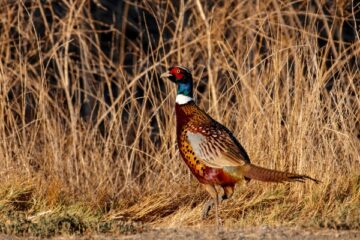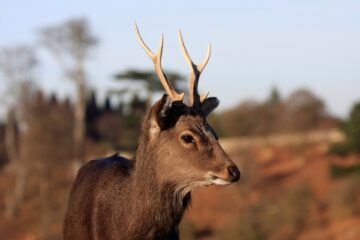My journey into deer stalking
I have been interested in country sports since being given a BB air rifle as a youngster, graduating onto .22 air rifles, garden guns and then 12 bores. For many years I have participated in target shooting as well as rough and driven shooting when time allows.
Living in East Anglia, where we have a multitude of deer, I had always been fascinated by the subject of deer stalking and management.
Pre DSC1 got me hooked
Having done a Pre Deer Stalking Certificate (DSC) 1 course locally several years ago, I was hooked.
Over the next few years, I researched this subject intensively and found that there are so many resources available online, in books and of course through BASC.
Having been a member of BASC for many years, I took advantage of the Hockwold Deer Stalking Scheme in Norfolk. What a fantastic innovation! To allow a novice rifle shooter the chance to fire a rifle on a range, fully supervised, and then have a morning or afternoon stalking under the guidance of an experienced and approachable stalker is incomparable and a fantastic member benefit. (More information on BASC’s deer stalking schemes can be found here).
It’s almost a no-brainer to say that anyone who is considering applying for a FAC for deer stalking should initially attend at least one or more of these sessions to gain the practical experience. The guide will welcome your questions, although silence is paramount while on the stalk itself!
Undertaking my DSC1
As well as subsequently doing my DSC1 at Lady’s Wood Shooting School, near Chipping Sodbury, I met some interesting like-minded people. I also joined a local gun club and managed to get some walk-round experience with some local deer managers. All the while completely absorbing myself in the subject.
The DSC1 Course is not to be taken lightly: it is intensive, interactive and very hard studying. The final day on the range can be instrumental to your success or failure. The safety aspect is stressed and re-stressed and of course, there can be no doubt that getting the qualification is a proud moment.
Of the 12 on the course I took, there were only eight passes. A failure means a retake on another course whenever or wherever you can.
A pre-requisite for FAC
A DSC1 is now considered a pre-requisite for most FAC applications for a stalking rifle calibre and almost mandatory for stalking in Scotland or on publicly owned land.
FACs are not handed out like sweets by constabularies. They check very thoroughly every application and an initial application, quite rightly, may take a few months.
For myself, having received an invitation to stalk in Scotland and having gained a tentative “permission” locally, this helped my case when applying for my licence.
My advice to anyone applying is to be very patient. Build up as much of a portfolio of experience as possible – attend courses, join a gun club and ask around. Be prepared to travel to get these opportunities too.
Processing the skills of a deer stalker
Skinning and butchering the deer is another art to be learned. It is a whole discipline in itself – especially if you save and prepare the deer skin to make rugs or throws, which I do. It’s quite an absorbing subject in itself!
I love the butchery side of the process. If done properly it is not messy or dirty, it’s like disassembling a three-dimensional puzzle. If you do it well, the final jointed product will sit proudly in your freezer. A small investment in a vacuum packer really helps the final presentation also as described in previous BASC articles.
Preparing the deer carcass
The qualities you need to do this properly are the same as those needed when you eventually get stalking on your own – time, perseverance, and patience.
Creeping through woodland as dawn breaks with your rifle somehow tugs on some very strong threads that join us to our primal forebears. The moment you spot a deer and wait for it to present a safe target, knowing that animal will be destined for the larder in a humane way, is an emotion hard to describe.
There is very little thinking time. But, if you have spotted the deer before it spots you, then your newly acquired skills should help deliver a satisfying outcome for you.
The gralloch and carcass inspection is a very necessary and vital task, which you will have trained for. And of course, the more you do the more you learn.
Pick of the crop
Amongst my other outdoor pursuits is a 20-year passion for wild mushrooms. This is not a subject to be taken lightly either, and as before, research and safety are also paramount. The good mushrooms you can eat should be easily distinguishable, such as cep, girolle, hedgehog mushrooms, morels, parasol and a few more.
If in doubt, don’t put it in the basket. This is exactly the same approach when you spot a deer, if it’s in season but not a safe shot, then don’t take it.
Near where I live, there are also an abundance of walnut trees. If you pick the nuts in early July while the skins are on and the shell is just forming, these will be ready for the winter months.
So, with venison, wild mushrooms and picked walnuts, what better way to combine them at this time of year than create a lovely warming winter dish. Here’s my recipe:
Port and porter venison
- Serves six (leftovers can be frozen)
- 1.5 kg cubed and trimmed venison
- 500 ml good dark porter beer
- 250 ml port
- A 350-500g jar of picked walnuts (drained)
- 2 chopped cooking onions
- 50-75g wild mushrooms, (Cep Chanterelles etc.) If unavailable, then chestnut mushrooms are fine
- 1 large, crushed clove of garlic
- 3 bay leaves
- A few twigs of thyme
- 1 teaspoon of juniper berries
- 2 tablespoons of well-seasoned flour for thickening
- Butter and cooking oil (equal amounts, just add as needed)
Method:
- Marinade the venison in the port and porter overnight, or for several hours, with the bay leaves thyme and juniper berries.
- Drain but keep the liquid aside.
- Dust the cubed venison in the flour mixture
- Brown off the venison in a large heavy casserole dish in batches using some of the butter and oil. Tip: put the browned venison on a plate as you go and don’t worry about the flour sticking to the pan.
- With the remainder of the oil/butter, soften the onions and add the mushrooms and garlic in the same pan creating a floury/buttery/oil mixture
- Add the marinade with the herbs and the venison.
- Bring to the boil on the hob then cover and cook for 1-1.5 hours in a medium oven, gas mark 3/4 (165 degrees Celsius).
- Give it a good stir and if needed, you may want to thicken and season to taste.
- Add the pickled walnuts and cook for another hour or so.
We are really dealing with the “heavy engineering” of cookery here. The timings can allow for longer if needed, and don’t get too precious about exact quantities either: it’s hard to ruin this dish!
- Before serving, pick out the thyme stalks and pull through a fork to release the leaves back into the casserole.
- Ideally serve with creamy mashed potatoes and some braised red cabbage.
Enjoy!



